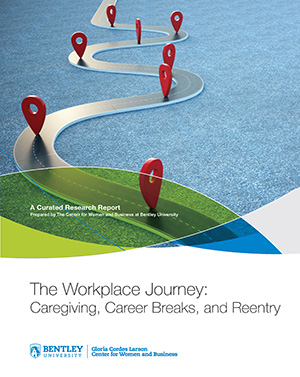Reentry Research Report Request
 Thank you for your interest in the Gloria Cordes Larson Center for Women and Business (CWB) curated research report The Workplace Journey: Caregiving, Career Breaks, and Reentry. Download the full report.
Thank you for your interest in the Gloria Cordes Larson Center for Women and Business (CWB) curated research report The Workplace Journey: Caregiving, Career Breaks, and Reentry. Download the full report.
Executive Summary
Caregiving in the U.S. provides a critical backdrop to the topic of workplace reentry. Workers overwhelmingly report that caregiving obligations negatively impact their ability to work productively, and a significant percentage of employees — primarily women — take leave for caregiving at some point throughout their career. Although most leave-takers want to return, a significant percentage won’t find a job comparable to their former position.
All genders are impacted by caregiving but the largest affected group is women, who represent approximately 75 percent of caregivers and carry the largest burden of unpaid caregiving in the U.S. While breakout data on how caregiving impacts women of color is limited, we know that they are disproportionately impacted and include such information where possible.
Reasons for workplace leaves vary from caregiving in all its unique forms to personal medical needs, elder care, and military service, but the primary driver is child care. While women disproportionately take on child care responsibilities, the number of men taking a break to stay at home with their children has increased significantly over the past decade. We explore the impact of caregiving and employer views and spotlight women returners.
The return process is often harder than expected, with surprising challenges impacting those reentering the workplace. Just a few examples of the hurdles that relaunchers need to overcome include: a decrease in confidence; a real or perceived deterioration of skills; and employer stigma about their commitment to work. Employees and employers alike should look at both the break and reentry process as part of a continuum, planning for reentry even before leave is taken.
Formal reentry programs, such as returnships, are proliferating. Well-executed returner programs can provide valuable on-ramps for employees and help organizations tap into highly skilled, motivated, and mature workers. We discuss the return process, the challenges, as well as returner programs.
Military veterans, critical and talented members the U.S. workforce, bring exceptional expertise to the civilian landscape. Yet they often face reentry challenges based on their own mindsets as well as those resulting from biases, hiring approaches, and onboarding processes in civilianrun organizations. We spotlight the experiences of veterans and the issues unique to female veterans .
Workplace leave for medical reasons is common. Of the approximately 20 million people who take unpaid leave each year through the Family and Medical Leave Act (FMLA), a significant majority use it to care for their own injuries or illnesses or for those of loved ones. In the workplace discussion around health and wellbeing, mental health is a rapidly growing concern and the increasing focus of research and media coverage. We identify unique considerations around leave and reentry related to medical needs, including mental health.
Recommendations for employee and employer alike are addressed at the end of the report. This section includes considerations ranging from how and why a work break might be needed to how to ensure a successful reentry. The appendices of the report include: a glossary of terms; a list of companies with on-ramp programs; and a list of workplace reentry resources

